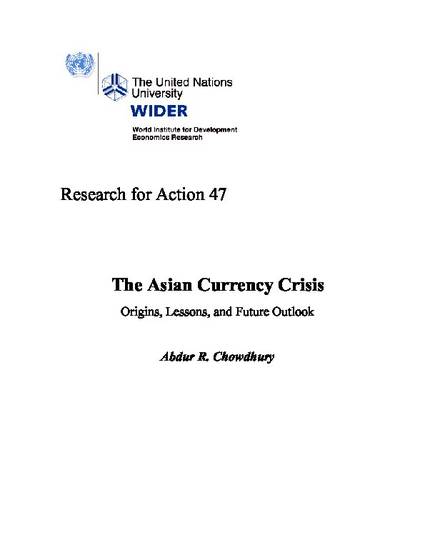
What started in the summer of 1997 as a regional economic and financial crisis in East and Southeast Asia had developed into a global financial crisis within the span of a year. This crisis followed the crisis in the European Monetary System in 1992-3 and the Mexican peso crisis in 1994-5. However, unlike the previous two crises, the scale and depth of the Asian crisis surprised everyone. Obvious reason for this is East and Southeast Asia's track record of economic success. Since the 1960s, no other group of countries in the world has produced more rapid economic growth or such a dramatic reduction in poverty. Given so many years of sustained economic performance the obvious question is: how could events in Asia unfold as they did? This paper has three objectives. First, to explain what led to this crisis and how did it spread throughout the region; second, to analyze the lessons that can be learned from this crisis to prevent it from reoccurring in the future and; third, to evaluate the future outlook of the countries in this region. The paper shows that what led to the crisis was a fatal combination of several self-reinforcing factors including external sector weaknesses, fragility in domestic financial markets due to inadequately administered financial liberalization, loss of confidence, and short-term capital flows, maturing within less than a year and denominated in unhedged dollars. Some of these factors were country-specific while others were common to the entire region. Asia's financial crisis will almost certainly lead to important changes in the international financial system, as countries try to find an appropriate balance between the benefits from gaining access to the international capital flows and the potential for instability and other risks that also seem to be much greater in a world of large and highly mobile capital movement. The paper discusses important lessons from the crisis. Some are preventive, designed to reduce the probability of financial crisis in the future, while others are more fundamental in nature. After the analysis of what went wrong and what we can learn from the crisis, comes the analysis of what happens next as Asian countries try to find their way back to economic stability and growth. The recovery process for these countries can be broadly divided into three phases. In the first phase, policies designed to address the causes of the crisis need to be formulated. In the second phase, a recovery of private capital inflow can be expected. The third and final phase of the process will be reached when the recapitalization of the financial system has been largely accomplished and when the level of private consumption and private investment have reached the pre-crisis level.
Available at: http://works.bepress.com/abdur_chowdhury/77/

Chowdhury, A. (1999). ‘The Asian Currency Crisis: Origins, Lessons, and Future Outlook’, UNU-WIDER Research for Action Series, 47, February 1999. Permalink.